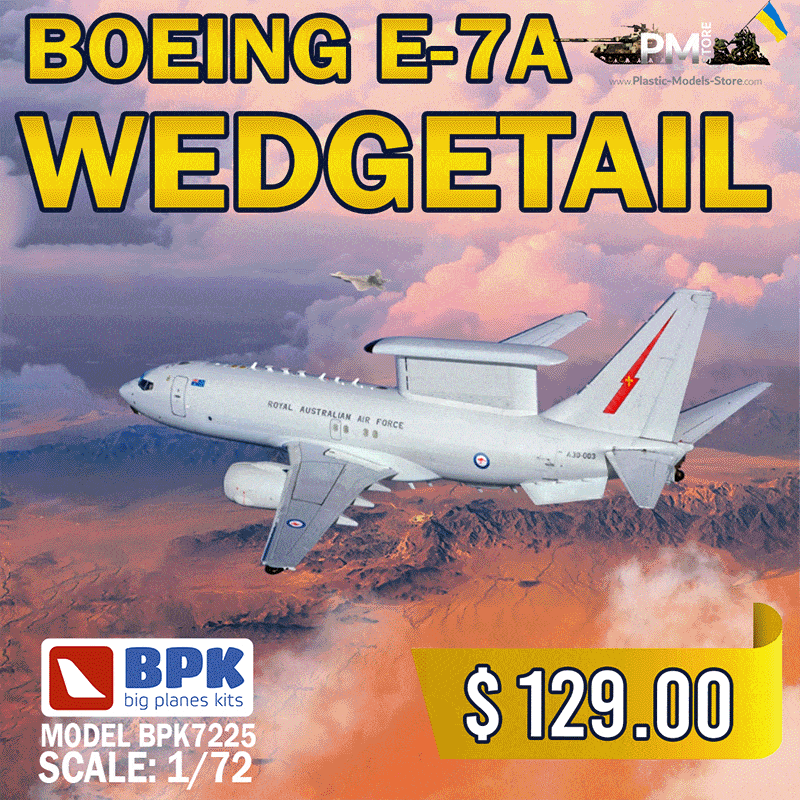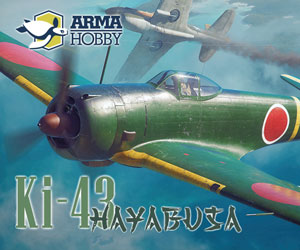
Background
The P-51H represented the ultimate WWII development of the Mustang, tackling a number of deficiencies in the famous P-51D/K, and in the process becoming one of the fastest propeller-driven fighters ever produced. North American's quest for a lighter weight design (tested in the XP-51F, 'G and '7) introduced a new wing aerofoil, plus a longer rear fuselage and taller fin, along with smaller undercarriage and many other detail changes. While it appeared very similar to the P-51D/K at first glance, it was a new design and perhaps its most distinctive feature was the deletion of the classic "kink" in the leading edge of each wing that was no longer needed due to the aircraft's smaller mainwheels.
Although the P-51H raised the Mustang's top speed to over 470mph, its arrival coincided with the development of the first generation of jet fighters that signalled the impending obsolescence of existing interceptors.
The P-51H arrived too late to see combat in WWII and production was terminated with the cessation of fighting, meaning only 550 were built of a planned 2,000. Most aircraft served with reserve units and it flew in this role well into the 1950s, and although the outbreak of war in Korea saw Mustangs once again in the thick of the fighting, it was the P-51D/K that was chosen despite the superiority of the P-51H. The reason was simple - the earlier model was available in far greater numbers and, importantly, was backed up by a correspondingly larger supply of spare parts. Thus the P-51H was destined to join most of the other "superprops" as an outstanding aircraft that simply arrived too late to see the success that it would otherwise have achieved.
The Kit
Despite the enormous popularity of the Mustang as a modelling subject, the P-51H has been largely overlooked in 1:48 except for a few short-run releases that were demanding to build and/or of dubious accuracy. That's all changed the arrival of Modelsvit's new-tool kit that finally gives the chance to build a model that's packed with detail and can happily sit alongside modern mainstream kits.
The kit arrives in a solid and attractive top-opening box, with the contents packed in resealable bags. Everything arrived perfectly intact in my kit.

The model comprises:
144 x grey styrene parts (+ 4 x unused)
9 x clear styrene parts
49 x photoetched parts
2 x rubber tyres
A sheet of die-cut film
A set of die-cut vinyl painting masks
Decals for 4 x colour schemes











With all due respect to Modelsvit, I think it's fair to describe the company as a smaller manufacturer and so one step removed from cutting edge mainstream. That said, their P-51H is light years removed from traditional short-run kits as we remember them from twenty or so years ago. It's a sophisticated kit in terms of design and, thankfully, it fully lives up to the designers' ambitions.
The parts are cleanly moulded with little or no flash, and no issues with sink marks. As with kits I've reviewed made by Dora Wings, there's no use made of ejection pins - a big bonus when it comes to preparing the parts, and something the "majors" could learn from. The only moulding flaws I've spotted are two faint "nipples" on one fuselage half that a few quick swipes with a polishing stick will take care of.
As soon as you begin to examine the main airframe parts, one thing stands out - the exceptional surface finish. The panel lines are subtle and there's a wonderfully light representation of rivets that rivals the latest Eduard kits. These are applied to the fuselage and tail surfaces, plus the underside centre panels of the wings. The rest of the wings are left smooth to depict how the full-sized surfaces were filled and painted.


Test Fit
I'm sure we've all been in situations where a kit looks great on the runners but is a pig to assemble, so I was keen to do a dry-fit of the main parts to see if this Mustang's beauty was only skin deep. The parts are moulded straight and true, and whilst the runner attachments are mostly on the mating surfaces, the styrene used trims easily, so clean-up proved quick and easy.
The fuselage halves line up perfectly and the stabilisers slot in neatly after easing their locating slots. I was particularly impressed by how well the wings attach, with a good tight fit at the roots - and this is without the interior installed, which may well also spread the fuselage a tad.
The roof of the mainwheel well is moulded integrally with each upper wing panel, with a joint in the middle that also helps maintain the correct dihedral - a very neat idea.
Based on the test fit, Modelsvit's P-51H promises to be a very enjoyable build with no obvious pitfalls highlighted.


A Few Details
Construction begins with the cockpit, which is impressively detailed by any standards. You're looking at over 40 parts in total, with a mix of styrene and etched pieces, and to augment the moulded detail, there are around 15 decals to apply around the "office" for panel fascias, instruments and data-plates
Modelsvit offer a choice of methods for the instrument panel - a decal over the moulded styrene part, or an etched panel over a decal of the instrument faces. Decals can struggle to snuggle down over moulded panels that have prominent raised details, but in this case the bezels on the styrene part are very shallow so the decal should sit fine. I'll still go for the classic etched "sandwich" approach, though, which should look excellent with drops of varnish to "glaze" the instruments.
The seat is constructed of 5 parts that include etched support stays, and is completed by a 6-part harness.










Turning to the undercarriage, the tailwheel is surprisingly well detailed, with a 5-part insert for the well, plus a 4-part wheel and strut.
The mainwheel assembly is a similar story, with a 12-part bay, plus nicely detailed legs with 2-part oleo scissors and delicate retraction arms. The mainwheels themselves feature well-moulded soft tyres. As so often with these type of tyres, they're rather "dust magnets" as shown in the accompanying photos and they may not be to everyone's taste, so it's good to see standard styrene wheels on the runners too (although they're not shown in the instructions). In either case the tyres have crisp treads and maker's logos etc. on the sidewalls.









Moving up front, the exhausts are hollowed out (you could drill them deeper for an even better look) and slot neatly into their moulded shrouds. The paddle-bladed prop is cleanly moulded as two parts that lock precisely into the spinner, and the whole assembly is designed to turn if you're careful applying cement.



Underwing ordnance comprises a pair of drop tanks and 6 x rockets on zero-length launchers. The launchers feature etched plates at their bases, and the rockets and tanks are supplied with servicing stencil decals. (Note: One point that the instructions miss is the need to open-up the locating holes for the rockets - if you don't do this you'll really be "flying blind" and risk marring the finish when you try to attach them.)


The canopy can be displayed open or closed and is cleanly moulded and free of distortion. The clear parts also include navigation and landing lamp covers, and Modelsvit provide vinyl masks for the canopy and wheels. A small sheet of die-cut film holds the gunsight reflector, with a couple of spares in case of accidents.

Instructions & Decals
The assembly guide is printed in colour as a classy 12-page booklet on good quality stock. Construction is broken down into 30 stages and the sequence looks pretty logical. The diagrams are well-sized and very clear, with colour matches for Gunze Sangyo paints given throughout.


Modelsvit include decals for four aircraft that offer a nice variety of colour schemes.
1. P-51H, s/n 44-64968, 66th FS, 57th FG, Alaska Air Command, 1948
2. P-51H, s/n 44-64566, 138th FIS, Syracuse, NY, 1953
3. P-51H, s/n 44-64461, "Ahm Available", 62nd FS, 56th FG, Alaska Air Command, 1948
4. P-51H, s/n 44-64346, 146th FIS, Pennsylvania ANG, 1954



The decals are beautifully printed by Decograph, with pin-sharp registration and minimal excess carrier film on most items. The decals are spread over two sheets and come complete with a comprehensive set of servicing stencils, for which Modelsvit provide a full-page placement guide.



Conclusion
It would be an understatement just to say I'm impressed by Modelsvit's P-51H, because it's totally exceeded my expectations. The superb surface finish is an eye-opener for a kit of this nature, and I have to admit I was fully prepared to have to deal with some fit issues, but the dry assembly indicates that fear should be groundless. That said, I'd still suggest the kit is best recommended for modellers with a bit of extra experience because of its use of photoetch, and I think parts will inevitably require a bit of preparation and adjustment. It's a quantum leap in quality compared with the old short run kits that I enjoy building, but the adage about test fitting everything twice (or more) before committing may still not go amiss.
I bought Modelsvit's kit #4821 from Jadlam Toys & Models (https://www.jadlamracingmodels.com/) for £39.95, which I feel represents good value for money for a model that promises to be a really enjoyable challenge.
Please remember, when contacting retailers or manufacturers, to mention that you saw their products highlighted here - on AEROSCALE




























